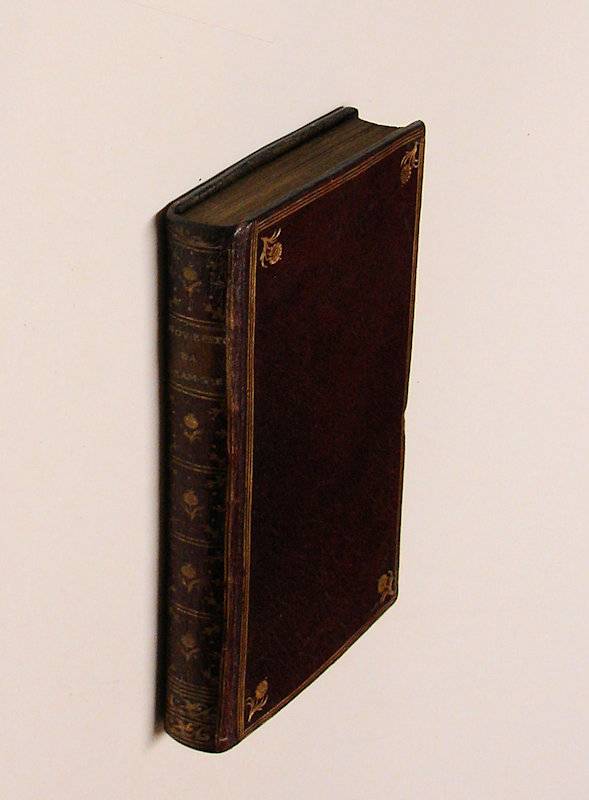NOVO EPITOME DA GRAMMATICA GREGA DE PORTO-REAL,
composto na lingoa portugueza, para uzo das novas escolas de Portugal e dedicado ao illustrissimo e reverendissimo senhor Pedro da Costa de Almeida Salema (...).
Paris, Na Officina de Franc. Ambr. Didot, 1760.
XVI,382,(2 blank) p. Calf 17.5 cm (
Details: Back gilt with floral elements, boards with triple fillet gilt borders and gilt corner pieces, the edges of the bookblock also gilt. Endpaper marbled) (
Condition: Some faint wear to the binding. Bookplate on the front pastedown. Front pastedown slightly damaged by the removal of an older bookplate. Library stamp on the front flyleaf) (
Note: Port-Royal was a cistercian monastery for women, in Magny-les-Hameaux, south-west of Paris. Several schools were founded there at the beginning of the 17th century, the so-called 'Petites-Écoles de Port-Royal'. The 'Little-Schools' were famous for the exceptional quality of the education that was provided there. The masters of Port Royal recognized that Latin had lost its utilitarian value, for it was no longer the only language of the learned. As Comenius had recommended, they adopted the vernacular as the ordinary medium of instruction. Their ingenuity to find the easiest and best teaching methods is preserved in the schoolbooks of the Port-Royalists. The masters of Port-Royal tried to remove difficulties from the path of the learner, and wanted to render instruction as pleasant as possible. Teachers therefore should not speak Latin, but speak the same vernacular as the pupil, and all explanations, and every grammar and lexicon should be adapted to the mother-tongue. The Port-Royalists found that children must especially be practised in the art of translation from Latin and Greek 'because the concentration needed for weighing all the phrases, and discovering the meaning of a Latin (or Greek) author, exercises both their intellect and their judgment at the same time, and makes them appreciate the beauty of the French as much as that of the Latin'. (H.C. Barnard, 'The little schools of Port-Royal', Cambridge 1913, p. 122) A good French style was considered of equal value with a polished Latin style. The Greek grammar of Port-Royal also sought to reduce the difficulties involved in the acquiring of a thorough knowledge of Greek grammar. It was produced by the French Jansenist monk and grammarian Claude Lancelot, ca. 1615-1695, who was involved in the foundation of the 'Petites-Écoles de Port-Royal' in 1638. His 'Nouvelle méthode pour apprendre la langue grecque' was first published in 1655. 'Greek at Port-Royal has a special interest to us because it gave birth to the two most important of all their school-books, Lancelot's 'Méthode grecque' and his 'Jardin de racines grecques'; (...) but its claim to originality lay in the fact that it was written in French and not in Latin. It also contained several simplifications designed to aid the student; for instance the declensions were reduced in number from ten, as had previously been customary, to two 'parisyllables' which are declined throughout with an equal number of syllables, and 'imparisyllables' which increase in the oblique cases; the conjunctions were also reduced to two: verbs ending in -ô and those ending in -mi. The 'Méthode' achieved an immediate success; in 40 years it went through nine editions and was translated into several foreign languages'. (Idem, p. 144) The monastery was demolished by the French state in 1710. In 1760, the Portuguese scholar Joâo Jacinto de Magalhâes, born in 1722, produced during his stay in Paris round 1760, as an act of patriotism for the 'utilidade publica', in order to restore Greek studies in Portugal, the Portuguese version of the Greek grammar of Lancelot. (p. a2 recto) That it met some success is proven by its second edition of 1814, 24 years after the death of Magalhâes. The book was printed in Paris, probably because there were no printers in Portugal who could print Greek type. Didot printed also copies with the imprint Lisboa, and without the printer's name. C. Morais dedicated an essay to this grammar in an article 'A gramática de Grego de João Jacinto de Magalhães no contexto da Reforma Pombalina' in 'Ágora. Estudos Clássicos em Debate', 1 (1999) p. 75-103) § Rare. In KVK we found only a few copies of this book, in the 'Bibliothèque Mazarine' in Paris, the 'Bayerische Staatsbibliothek' and the 'Biblioteca Nacional de Portugal') (
Provenance: On the front pastedown the bookplate of 'Bibliotheca Hagaveldensis'. On the front flyleaf a library stamp: 'Bibl. Hageveld, Plank 3, Kast 13'. The Seminary of Hageveld was founded by the diocese of Haarlem in 1817 in Santpoort, and transformed into 'College Hageveld' in 1967) (
Collation: a8, A4,*2, B6 - F6, G4, *2, H6-2H6, I4, 2K2 (leaf 2K2 blank) (Photographs on request)
Book number: 120284 Euro 350.00
Keywords: (Oude Druk), (Rare Books), Grammatik, Greek linguistics, Portugal, Schulbuch, antike altertum antiquity, grammar, griechische Sprachwissenschaft, schoolbook
 NOVO EPITOME DA GRAMMATICA GREGA DE PORTO REAL,
NOVO EPITOME DA GRAMMATICA GREGA DE PORTO REAL,